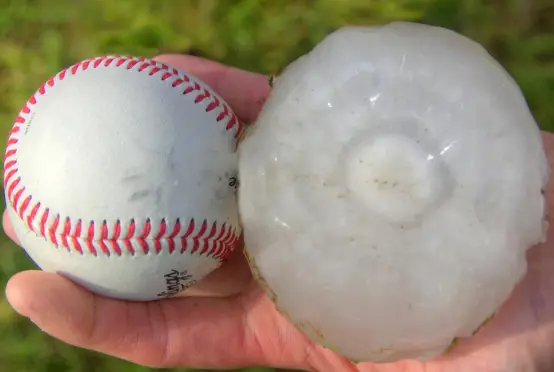Hailstorms pack a powerful punch, causing significant damage and posing risks to safety and agriculture. Understanding the impact of hail is crucial for preparedness and mitigation. This guide explores the importance of deciphering hail size and the challenges involved. Balancing factors like forecast accuracy and timely warnings is essential for decision-making regarding the Hail Size Size Chart, prioritizing safety and community well-being.
Hail Size Chart
| Hail Diameter Size (Inches) | Description |
|---|---|
| 1/4 | Pea Size |
| 1/2 | Mothball, peanut, USB Plug |
| 3/4 | Penny Size |
| 7/8 | Nickel Size |
| 1 | Quarter Size |
| 1 1/4 | Half Dollar Size |
| 1 1/2 | Ping Pong Ball Size |
| 1 3/4 | Golf Ball Size |
| 2 | Lime or medium-sized Hen Egg |
| 2 1/2 | Tennis Ball Size |
| 2 3/4 | Baseball Size |
| 3 | Large Apple |
| 4 | Softball |
| 4 1/2 | Grapefruit |
| Freeze it, Measure it, and Notify the NWS. | Probably a record-sized hailstone for Idaho or Oregon |
| Freeze it, Measure it, Notify the NWS. |
Factors Influencing Hail Size
Hail size hinges on several atmospheric conditions. Exploring these factors sheds light on hail formation. Strong updrafts play a pivotal role, propelling water droplets to higher altitudes where they freeze and accumulate layers, forming larger hailstones.
Understanding these dynamics is crucial for deciphering hail size accurately. Balancing factors like atmospheric instability and moisture content presents challenges in forecasting hail size. Thus, decisions about the Hail Size Size Chart must consider these complexities to ensure effective preparedness and response.

The Hail Size Chart: Deciphering the Dimensions
Deciphering hail size involves establishing clear parameters. Small hail, ranging from pea to marble size, may seem innocuous but can still cause damage. Transitioning to medium-sized hail, from quarter to golf ball size, poses increased dangers, including vehicle damage and injury risk. Large hailstones, from tennis ball to softball size, carry immense destructive potential, threatening property and safety.
Rare but extremely hazardous, giant hailstones, grapefruit size and above, present significant challenges in forecasting and mitigation. Balancing the tradeoffs between granularity and simplicity in the Hail Size Size Chart is essential for effective communication and preparedness.
Understanding Hail Damage
Hail wreaks havoc on various fronts, from property to agriculture and safety. Detailing the impact on property reveals the extent of damage inflicted on vehicles, roofs, and other structures. Moreover, exploring its agricultural implications uncovers the devastating effects on crops and livelihoods.
Safety concerns loom large, with humans and animals facing significant risks during hailstorms.
Safety Tips and Precautions
When it comes to safety during hailstorms, seeking shelter is paramount. Advising on the best course of action ensures individuals can protect themselves effectively. Additionally, providing tips for safeguarding vehicles and homes from hail damage is essential for mitigating losses.
Incorporating emergency preparedness measures into a hailstorm plan is crucial, balancing proactive steps with practical considerations. Decisions regarding the Hail Size Size Chart must prioritize safety and preparedness, acknowledging the impact on lives and property.
Forecasting and Monitoring Hailstorms
Meteorological Tools play a crucial role in tracking and predicting hailstorms. Explaining the technology behind these tools illuminates the process of monitoring atmospheric conditions. However, accurately forecasting hail size presents challenges, considering the dynamic nature of hail formation and the limitations of current predictive models.
Historical Hailstorms and Notable Events
Recounting Famous Hailstorms provides valuable insights into past events that captured public attention due to their size or impact. Extracting Lessons Learned from these historical occurrences is essential for improving future preparedness.
By analyzing past experiences, we can better understand the complexities of hailstorms and refine strategies for mitigating their effects. Balancing the lessons from history with the challenges of forecasting underscores the importance of informed decision-making regarding the Hail Size Size Chart.
Conclusion
Understanding hail size is paramount for safety and preparedness. Summarizing key takeaways underscores its significance in mitigating risks during hailstorms. Balancing factors like forecast accuracy and practicality presents challenges, but informed decision-making is essential. Ultimately, prioritizing safety in decisions regarding the Hail Size Size Chart ensures communities are equipped to minimize the impact of hailstorms on lives and property.
FAQs
FAQ: How is hail size measured?
Answer: Hail size is typically measured using diameter ranges, such as pea-sized, quarter-sized, or softball-sized. Meteorologists determine the size by observing the diameter of the hailstone after it has fallen to the ground.
FAQ: Can hail cause significant property damage?
Answer: Yes, hail can cause extensive damage to vehicles, roofs, windows, and other structures. The severity of the damage depends on the size and density of the hailstones, as well as the material and construction of the affected property.
FAQ: Are there safety precautions individuals can take during a hailstorm?
Answer: Absolutely. Seeking shelter indoors or in a sturdy building is the safest course of action during a hailstorm. If indoors is not an option, find shelter in a vehicle with a sturdy roof. Additionally, wearing helmets and protective gear can reduce the risk of injury if caught outside during a hailstorm.
FAQ: How accurate are hail size forecasts?
Answer: Hail size forecasts can vary in accuracy depending on several factors, including the complexity of the storm system, the availability of data, and the limitations of predictive models. While meteorologists strive for precision, there can still be uncertainties in predicting exact hail size.
FAQ: What are the agricultural implications of hailstorms?
Answer: Hailstorms can devastate crops, leading to significant economic losses for farmers and impacting food supply chains. Crop damage from hail can range from bruising and leaf stripping to complete destruction, depending on the severity of the storm and the stage of crop development.